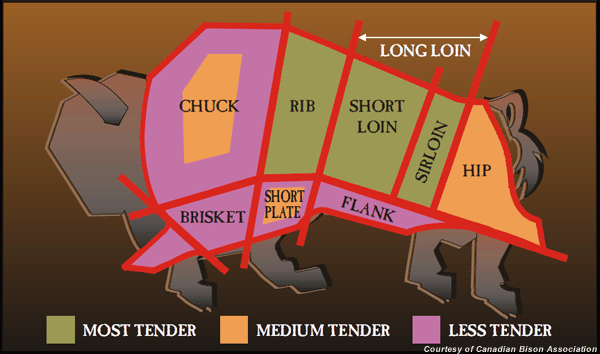As a lover of delicious, nutritious bison meat, you want to make sure you’re getting the most from this tasty ingredient. But since bison is a perishable food, it’s crucial to know how to tell if your meat has gone bad before eating it.
In my years as a bison farmer and meat processor, I’ve become an expert on identifying spoiled bison. By looking for key signs of spoilage in the smell, texture, and appearance of the meat, you can easily discern if your bison is still fresh or if it’s time to toss it.
In this comprehensive guide I’ll walk you through the clear indications that bison has gone bad as well as proper storage tips to maximize its freshness and shelf life. Let’s dive in!
Trust Your Nose: Smell for Off Odors
Your sense of smell is one of the best tools for detecting spoiled bison. Fresh bison meat has a mild beefy aroma. If you detect foul unpleasant odors, it means bacteria have started breaking the meat down. Key bad smells include
-
Sour, acidic scent
-
Ammonia-like, pungent odor
-
Rotten, sulfurous smell
-
Overall “off” or unpleasant stench
If your bison gives off any of these red flags, it’s safest not to risk eating it. Remember, your nose knows when meat has turned!
Examine the Texture for Sliminess
Along with the smell, closely inspecting the texture of bison can confirm spoilage. Fresh bison has a firm, smooth texture. If you notice any sticky, glossy or slime coating on the meat, bacteria are present. Other problematic textures include:
-
Unusual mushiness or soft spots
-
Abnormal graininess or grittiness
-
Overall change in density and consistency
Any kind of slimy, stringy or mushy feel is a huge warning that your bison has gone bad. Promptly discard it.
Check for Unnatural Discoloration
The natural color of fresh bison is a deep cherry red. Over time, properly stored meat will turn a deeper burgundy as it oxygenates. However, unnatural gray, brown or green hues signal spoilage. Watch for:
-
Grayish, dull or dirty looking meat
-
Greenish, blue-ish discoloration
-
Brown or black spots
While some marbling is normal, odd colors like these mean bacteria and molds have set in. When in doubt, throw it out!
Know Proper Handling and Storage
To get the most out of your bison and avoid waste, proper handling and storage are key. Here are tips:
-
Refrigerate fresh bison at 40°F or below
-
Freeze raw bison within 2 days of purchase
-
Thaw bison meat safely in the refrigerator
-
Separate raw bison from other foods
-
Cook bison patties and steaks to 160°F minimum
Following safe practices greatly reduces the chances of your fresh bison going bad prematurely.
Dispose of Spoiled Meat Properly
If you confirm your bison has spoiled, be sure to throw it away properly. Follow these guidelines:
-
Double wrap in plastic bags and tie securely
-
Label bags clearly as “spoiled food – do not eat”
-
Discard in outside garbage bins, not your kitchen pail
-
Never try composting spoiled raw meat
Proper disposal prevents contamination and protects your family’s health. Don’t take risks with iffy meat!
Trust Your Senses to Enjoy Delicious Bison
With the right storage and handling, you can enjoy fresh, high-quality bison meat for a good amount of time. If you ever question if your bison has gone bad, rely on your senses. Remember:
-
Let your nose detect any fouls smells
-
Check for odd textures like slime
-
Watch for unnatural discoloration
-
When in doubt, play it safe and toss it out!
Following these guidelines removes the guesswork and gives you confidence your bison is fresh and safe to eat. Trust your senses, and enjoy this tasty, nutrient-packed meat to its fullest potential.

Ways to Tell if Meat is Bad
See if the meat has a bad smell, changes color, or mold on it. These are the most obvious signs that meat has gone bad. If it feels slimy or sticky, it’s probably time to throw it out. Always check the expiration date and toss expired meat to avoid food poisoning.
Signs that Meat is Bad
- Do not taste meat that you aren’t sure about to see if it has gone bad. People who eat small amounts of spoiled food can get food poisoning. Thanks Helpful 0 Not Helpful 0 .
Advertisement
How can I tell if my meat’s gone bad?
What does bison taste like?
Bison has a lighter, fresher flavor than beef. Some people describe bison as having a slight sweetness or a subtle grassiness. Bison does not taste gamey like goat or deer. Is bison meat healthy to eat? Bison meat contains less harmful fat and more good fat along with a broad range of important vitamins and mineral nutrients.
Is bison good for You?
Bison meat is a good source of omega-3 fatty acids, vitamin b-12, and nutrients including iron, zinc, and selenium. In fact, replacing all or part of your beef with bison can help reduce LDL or bad cholesterol for individuals on a heart-healthy diet. A key difference between bison and beef is the dramatically different fat content.
Is bison healthier than beef?
Bison is leaner than beef and may be a healthier choice if you’re looking to reduce your calorie or fat intake. It has nearly 25% fewer calories than beef and is lower in total and saturated fat ( 2, 3 ). Additionally, due to its lower fat content, bison has finer fat marbling, yielding softer and more tender meat.
How do you know if meat is bad?
Check the meat for a foul smell. If your meat smells rancid, it most likely is. Spoiled red meat has a distinct, pungent ammonia scent. Throw your meat away if it has a bad odor, especially if the meat’s expiration date has passed. Do not press your nose against or near the meat to smell it.
